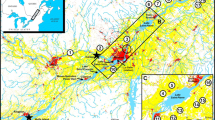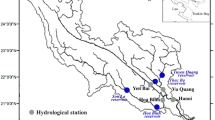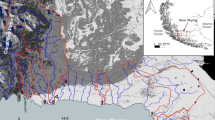Abstract
The Red River, draining a 169,000 km2 watershed, is the second largest river in Viet Nam and constitutes the main source of water for a large percentage of the population of North Viet Nam. Here we present the results of an investigation into the spatial distribution and temporal dynamics of particulate and dissolved organic carbon (POC and DOC, respectively) in the Red River Basin. POC concentrations ranged from 0.24 to 5.80 mg C L−1 and DOC concentrations ranged from 0.26 to 5.39 mg C L−1. The application of the Seneque/Riverstrahler model to monthly POC and DOC measurements showed that, in general, the model simulations of the temporal variations and spatial distribution of organic carbon (OC) concentration followed the observed trends. They also show the impact of high population densities (up to 994 inhab km−2 in the delta area) on OC inputs in surface runoff from the different land use classes and from urban point sources. A budget of the main fluxes of OC in the whole river network, including diffuse inputs from soil leaching and runoff and point sources from urban centers, as well as algal net primary production and heterotrophic respiration was established using the model results. It shows the predominantly heterotrophic character of the river system and provides an estimate of CO2 emissions from the river of 330 Gg C year−1. This value is in reasonable agreement with the few available direct measurements of CO2 fluxes in the downstream part of the river network.








Similar content being viewed by others
References
Aitkenhead MJ, Aitkenhead-Peterson JA, McDowell WH, Smart RP, Cresser MS (2007) Modelling DOC export from watersheds in Scotland using neural networks. Comput Geosci 33:423–436
Aitkenhead-Peterson JA, McDowell WH, Neff JC (2003) Sources, production and regulations of allochthonous dissolved organic matter inputs to surface waters. In: Findlay SEG, Sinsabaugh RL (eds) Aquatic ecosystems: interactivity of dissolved organic matter. Academic, San Diego, pp 21–70
Aristi I et al (2014) Flow regulation by dams affects ecosystem metabolism in Mediterranean rivers. Freshw Biol 59:1816–1829. https://doi.org/10.1111/fwb.12385
Asmala E, Autio R, Kaartokallio H, Pitkänen L, Stedmon CA, Thomas DN (2013) Bioavailability of riverine dissolved organic matter in three Baltic Sea estuaries and the effect of catchment land use. Biogeosciences 10:6969–6986
Band LE, Tague CL, Groffman P, Belt K (2001) Forest ecosystem processes at the watershed scale: hydrologic and ecological controls of nitrogen export. Hydrol Process 15:2013–2028
Baric D, Sigvardsson E (2007) Distribution and mobilisation of arsenic in Red River delta aquifers, Viet Nam. Department of Earth Sciences, Goteborg University, Goteberg
Beman MJ, Arrigo KR, Matson PA (2005) Agricultural runoff fuels large phytoplankton blooms in vulnerable areas of the ocean. Nature 434:211–214. https://doi.org/10.1038/nature03370
Bianchi TS, Wysocki LA, Stewart M, Filley TR, McKee BA (2007) Temporal variability in terrestrially-derived sources of particulate organic carbon in the lower Mississippi River and its upper tributaries. Geochim Cosmochim Acta 71:4425–4437. https://doi.org/10.1016/j.gca.2007.07.011
Billen G, Garnier J (1999) Nitrogen transfers through the Seine drainage network: a budget based on the application of the ‘Riverstrahler’ model. Hydrobiologia 410:139–150. https://doi.org/10.1023/a:1003838116725
Billen G, Garnier J, Hanset P (1994) Modeling phytoplankton development in whole drainage networks—the Riverstrahler model applied to the Seine River system. Hydrobiologia 289:119–137. https://doi.org/10.1007/bf00007414
Billen G, Thieu V, Garnier J, Silvestre M (2009) Modelling the N cascade in regional watersheds: the case study of the Seine, Somme and Scheldt Rivers. Agric Ecosyst Environ 133:234–246. https://doi.org/10.1016/j.agee.2009.04.018
Bonilla-Findji O, Rochelle-Newall E, Weinbauer MG, Pizay MD, Kerros ME, Gattuso JP (2009) Effect of seawater–freshwater cross-transplantations on viral dynamics and bacterial diversity and production. Aquat Microb Ecol 54:1–11
Borges AV et al (2015) Globally significant greenhouse-gas emissions from African inland waters. Nat Geosci 8:637–642. https://doi.org/10.1038/ngeo2486
Borges AV, Abril G, Bouillon S (2018) Carbon dynamics and CO2 and CH4 outgassing in the Mekong delta. Biogeosciences 15:1093–1114. https://doi.org/10.5194/bg-15-1093-2018
Bouillon S et al (2012) Organic matter sources, fluxes and greenhouse gas exchange in the Oubangui River (Congo River Basin). Biogeosciences 9:2045–2062. https://doi.org/10.5194/bg-9-2045-2012
Carlson CA, Ducklow HW, Hansell DA, Smith WO (1998) Organic carbon partitioning during spring phytoplankton blooms in the Ross Sea polynya and the Sargasso Sea. Limnol Oceanogr 43:375–386
Causse J et al (2015) Field and modelling studies of Escherichia coli loads in tropical streams of montane agro-ecosystems. J Hydro-environ Res 9:496–507. https://doi.org/10.1016/j.jher.2015.03.003
Chu AD, Pham MC, Nguyen MK (2010) Characteristic of urban wastewater in Hanoi City—nutritive value and potential risk in using for agriculture. J Sci Earth Sci Vietnam Natl Univ 26:42–47
Clair TA, Ehrman JM (1996) Variations in discharge and dissolved organic carbon and nitrogen export from terrestrial basins with changes in climate: a neural network approach. Limnol Oceanogr 41:921–927
Cole JJ, Caraco NF (2001) Carbon in catchments: connecting terrestrial carbon losses with aquatic metabolism. Mar Freshw Res 52:101–110
Cole JJ et al (2007) Plumbing the global carbon cycle: integrating inland waters into the terrestrial carbon budget. Ecosystems 10:171–184
Coynel A, Seyler P, Etcheber H, Meybeck M, Orange D (2005) Spatial and seasonal dynamics of total suspended sediment and organic carbon species in the Congo River. Glob Biogeochem Cycles 19:GB4019. https://doi.org/10.1029/2004gb002335
Dang TH (2011) Erosion et transferts de matières en suspension, carbone et métaux dans le bassin versant du Fleuve Rouge depuis la frontière sino-vietnamienne jusqu’a l’entrée du delta. PhD Thesis, Université de Bordeaux 1
Davies PM, Bunn SE, Hamilton SK (2008) Primary production in tropical streams and rivers. In: Dudgeon D (ed) Tropical stream ecology. Elsevier, Burlington, pp 23–42
Dixon JL, Beale R, Sargeant S, Tarran G, Nightingale PD (2014) Microbial acetone oxidation in coastal seawater. Front Microbiol 5:243. https://doi.org/10.3389/fmicb.2014.00243
Dodds WK, Veach AM, Ruffing CM, Larson DM, Fischer JL, Costigan KH (2013) Abiotic controls and temporal variability of river metabolism: multiyear analyses of Mississippi and Chattahoochee River data. Freshw Sci 32:1073–1087
Downing JA et al (2008) Sediment organic carbon burial in agriculturally eutrophic impoundments over the last century. Glob Biogeochem Cycles 22:GB1018
Farjalla VF, Amado AM, Suhett AL, Meirelles-Pereira F (2009) DOC removal paradigms in highly humic aquatic ecosystems. Environ Sci Pollut Res 16:531–538
Fenner N, Freeman C, Reynolds B (2005) Observations of a seasonally shifting thermal optimum in peatland carbon-cycling processes; implications for the global carbon cycle and soil enzyme methodologies. Soil Biol Biochem 37:1814–1821
Findlay S (2003) Bacterial response to variation in organic matter. In: Findlay S, Sinsabaugh RL (eds) Aquatic ecosystems: interactivity of dissolved organic matter. Academic, Amsterdam, pp 363–379
Finlay JC (2011) Stream size and human influences on ecosystem production in river networks. Ecosphere 2:1–21. https://doi.org/10.1890/es11-00071.1
Fuhrman J (1987) Close coupling between release and uptake of dissolved free amino acids in seawater studied by an isotope dilution approach. Mar Ecol Prog Ser 37:45–52
Garnier J, Billen G, Servais P (1992) Physiological characteristics and ecological rôle of small and large sized bacteria in a polluted river (Seine River, France). Arch Hydrobiol 37:83–94
Garnier J, Billen G, Coste M (1995) Seasonal succession of diatoms and chlorophyceae in the drainage network of the Seine River—observations and modeling. Limnol Oceanogr 40:750–765
Garnier J, Billen G, Hannon E, Fonbonne S, Videnina Y, Soulie M (2002) Modelling the transfer and retention of nutrients in the drainage network of the Danube River. Estuar Coast Shelf Sci 54:285–308. https://doi.org/10.1006/ecss.2000.0648
Garnier J, Billen G, Even S, Etcheber H, Servais P (2008) Organic matter dynamics and budgets in the turbidity maximum zone of the Seine Estuary (France). Estuar Coast Shelf Sci 77:150–162. https://doi.org/10.1016/j.ecss.2007.09.019
Garnier J, Mounier EM, Laverman AM, Billen G (2010) Potential denitrification and N2O production in the sediments of the Seine River drainage network (France). J Environ Qual 39:449–459
Genzoli L, Hall RO Jr (2016) Shifts in Klamath River metabolism following a reservoir cyanobacterial bloom. Freshw Sci 35:795–809. https://doi.org/10.1086/687752
Hall ROJ, Yackulic CB, Kennedy TA, Yard MD, Rosi-Marshall EJ, Voichick N, Behn KE (2015) Turbidity, light, temperature, and hydropeaking control primary productivity in the Colorado River, Grand Canyon. Limnol Oceanogr 60:512–526
Hansell DA, Carlson CA, Schlitzer R (2012) Net removal of major marine dissolved organic carbon fractions in the subsurface ocean. Glob Biogeochem Cycles 26:GB1016. https://doi.org/10.1029/2011gb004069
Ho KC, Hui KCC (2001) Chemical contamination of the East River (Dongjiang) and its implication on sustainable development in the Pearl River Delta. Environ Int 26:303–308
Hoellein TJ, Bruesewitz DA, Richardson DC (2013) Revisiting Odum (1956): a synthesis of aquatic ecosystem metabolism. Limnol Oceanogr 58:2089–2100. https://doi.org/10.4319/lo.2013.58.6.2089
Holmes RM, McClelland JW, Raymond PA, Frazer BB, Peterson BJ, Stieglitz M (2008) Lability of DOC transported by Alaskan rivers to the Arctic Ocean. Geophys Res Lett 35:L03402
Hosen JD, McDonough OT, Febria CM, Palmer MA (2014) Dissolved organic matter quality and bioavailability changes across an urbanization gradient in headwater streams. Environ Sci Technol 48:7817–7824
Huang T-H, Fu Y-H, Pan P-Y, Chen C-TA (2012) Fluvial carbon fluxes in tropical rivers. Curr Opin Environ Sustain 4:162–169. https://doi.org/10.1016/j.cosust.2012.02.004
IMH (1997–2004) Vietnamese journal of meteo-hydrology. Institute of Meteo-Hydrology (IMH) in Vietnam, Hanoi (in Vietnamese)
IMRR (2010) Main river delta. Italian Ministry of Foreign Affairs (IMRR), Rome
IPCC (2013) Summary for policymakers. Cambridge University Press, Cambridge
Jassby AD, Cloern JE, Cole BE (2002) Annual primary production: patterns and mechanisms of change in a nutrient-rich tidal ecosystem. Limnol Oceanogr 47:698–712
Kang PG, Mitchell MJ (2013) Bioavailability and size-fraction of dissolved organic carbon, nitrogen, and sulfur at the Arbutus Lake watershed, Adirondack Mountains, NY. Biogeochemistry 115:213–234
Katsoyiannis A, Samara C (2007) The fate of dissolved organic carbon (DOC) in the wastewater treatment process and its importance in the removal of wastewater contaminants. Environ Sci Pollut Res 14:284–292
Knapik HG, Fernandes CoVS, de Azevedo JCR, dos Santos MM, Dall’Agnol PC, Fontane DG (2015) Biodegradability of anthropogenic organic matter in polluted rivers using fluorescence, UV, and BDOC measurements. Environ Monit Assess. https://doi.org/10.1007/s10661-015-4266-3
Laudon H et al (2011) Patterns and dynamics of dissolved organic carbon (DOC) in boreal streams: the role of processes, connectivity, and scaling. Ecosystems 14:880–893
Le TPQ et al (2016) Carbon fluxes and emission from the Red River (Vietnam and China): human activities and climate change. Final Report ARCP2014-03CMY-Quynh
Le TPQ, Billen G, Garnier J, Thery S, Fezard C, Minh CV (2005) Nutrient (N, P) budgets for the Red River Basin (Vietnam and China). Glob Biogeochem Cycles 19:GB2022. https://doi.org/10.1029/2004gb002405
Le TPQ, Billen G, Garnier J, Thery S, Ruelland D, Nghiem XA, Chau VM (2010) Nutrient (N, P, Si) transfers in the subtropical Red River system (China and Vietnam): modelling and budget of nutrient sources and sinks. J Asian Earth Sci 37:259–274. https://doi.org/10.1016/j.jseaes.2009.08.010
Le TPQ et al (2013) Carbon flux and emissions from the Red River: human activities and climate change, vol 3. Asia–Pacific Network for Global Change Research, Kobe
Le TPQ, Billen G, Garnier J, Chau VM (2015) Long-term biogeochemical functioning of the Red River (Vietnam): past and present situations. Reg Environ Change 15:329–339. https://doi.org/10.1007/s10113-014-0646-4
Luu TNM et al (2010) Hydrological regime and water budget of the Red River Delta (Northern Vietnam). J Asian Earth Sci 37:219–228. https://doi.org/10.1016/j.jseaes.2009.08.004
Mann PJ et al (2012) Controls on the composition and lability of dissolved organic matter in Siberia’s Kolyma River Basin. J Geophys Res 117:G01028
Menon P, Billen G, Servais P (2003) Mortality rates of autochthonous and fecal bacteria in natural and aquatic ecosystems. Water Res 37:4151–4158
Meybeck M (1982) Carbon, nitrogen and phosphorus transport by world rivers. Am J Sci 282:401–450
MONRE (2009–2014) Environment report of Vietnam. Ministry of Natural Resource and Environment (MONRE), Ha Noi
Moreira-Turcq PF, Seyler P, Guyot JL, Etcheber H (2003) Characteristics of organic matter in the mixing zone of the Rio Negro and Rio Solimões of the Amazon River. Hydrol Process 17:1393–1404. https://doi.org/10.1002/hyp.1291
Nguyen TMH, Le TPQ, Garnier J, Janeau JL, Rochelle-Newall E (2016) Seasonal variability of faecal indicator bacteria numbers and die-off rates in the Red River Basin, North Viet Nam. Sci Rep 6:21644. https://doi.org/10.1038/srep21644
Ni H-G, Lu F-H, Luo X-L, Tian H-Y, Zeng EY (2008) Riverine inputs of total organic carbon and suspended particulate matter from the Pearl River Delta to the coastal ocean off South China. Mar Pollut Bull 56:1150–1157
Ouattara NK, Passerat J, Servais P (2011) Faecal contamination of water and sediment in the rivers of the Scheldt drainage network. Environ Monit Assess 183:243–257. https://doi.org/10.1007/s10661-011-1918-9
Parr TB, Cronan CS, Ohno T, Findlay SEG, Smith SMC, Simon KS (2015) Urbanization changes the composition and bioavailability of dissolved organic matter in headwater streams. Limnol Oceanogr 60:885–900
Pham MH, Nguyen TN, Nguyen HM, Pham HV, Berg M, Alder AC, Giger W (2010) Recent levels of organochlorine pesticides and polychlorinated biphenyls in sediments of the sewer system in Hanoi, Vietnam. Environ Pollut 158:913–920
Pommier T et al (2014) Off-site impacts of agricultural composting: role of terrestrially derived organic matter in structuring aquatic microbial communities and their metabolic potential. FEMS Microbiol Ecol 90:622–632. https://doi.org/10.1111/1574-6941.12421
Raymond PA, Saiers JE (2010) Event controlled DOC export from forested watersheds. Biogeochemistry 100:197–209. https://doi.org/10.1007/s10533-010-9416-7
Richey JE, Melack JM, Aufdenkampe AK, Ballester VM, Hess LL (2002) Outgassing from Amazonian Rivers and wetlands as a large tropical source of atmospheric CO2. Nature 416:617–620. https://doi.org/10.1038/416617a
Rivkin RB, Legendre L (2001) Biogenic carbon cycling in the upper ocean: effects of microbial respiration. Science 291:2398–2400
Rochelle-Newall EJ, Pizay MD, Middelburg JJ, Boschker HTS, Gattuso J-P (2004) Degradation of riverine dissolved organic matter by seawater bacteria. Aquat Microb Ecol 37:9–22
Rochelle-Newall EJ et al (2011) Phytoplankton diversity and productivity in a highly turbid, tropical coastal system (Bach Dang Estuary, Vietnam). Mar Pollut Bull 62:2317–2329
Rovelli L, Attard KM, Binley A, Heppell CM, Stahl H, Trimmer M, Glud RN (2017) Reach-scale river metabolism across contrasting sub-catchment geologies: effect of light and hydrology. Limnol Oceanogr 62:S381–S399. https://doi.org/10.1002/lno.10619
Ruelland D, Billen G, Brunstein D, Garnier J (2007) SENEQUE: a multi-scaling GIS interface to the Riverstrahler model of the biogeochemical functioning of river systems. Sci Total Environ 375:257–273. https://doi.org/10.1016/j.scitotenv.2006.12.014
Sarin MM, Sudheer AK, Balakrishna K (2002) Significance of riverine carbon transport: a case study of a large tropical river, Godavari (India). Sci China C 45:97–108
Sarma VVSS et al (2009) Influence of river discharge on plankton metabolic rates in the tropical monsoon driven Godavari Estuary, India. Estuar Coast Shelf Sci 85:515–524. https://doi.org/10.1016/j.ecss.2009.09.003
Schiff SL, Aravena R, Trumbore SE, Hinton MJ, Elgood R, Dillon PJ (1997) Export of DOC from forested catchments on the Precambrian Shield of central Ontario: clues from 13C and 14C. Biogeochemistry 36:43–65
Servais P, Barillier A, Garnier J (1995) Determination of the biodegradable fraction of dissolved and particulate organic carbon in waters. Ann Limnol 31:75–80. https://doi.org/10.1051/limn/1995005
Servais P, Billen G, Garnier J, Idlafkih Z, Mouchel JM, Seidl M, Meybeck M (1998) Le carbone organique (Chapitre 10). In: Meybeck M, De Marsily G, Fustec E (eds) La Seine en son bassin. Fonctionnement écologique d’un système fluvial anthropisé. Elsevier, Paris, pp 483–529
Servais P, Garnier J, Demarteau N, Brion N, Billen G (1999) Supply of organic matter and bacteria to aquatic ecosystems through waste water effluents. Water Res 33:3521–3531. https://doi.org/10.1016/s0043-1354(99)00056-1
Servais P, Garcia-Armisen T, George I, Billen G (2007) Fecal bacteria in the rivers of the Seine drainage network (France): sources, fate and modelling. Sci Total Environ 375:152–167. https://doi.org/10.1016/j.scitotenv.2006.12.010
Shanahan P, Henze M, Koncsos L, Rauch W, Reichert P, Somlyódy L, Vanrolleghem P (1998) River water quality modelling: II. Problems of the art. Water Sci Technol 38:245–252
Sondergaard M, Middelboe M (1995) A cross-system analysis of labile dissolved organic-carbon. Mar Ecol Prog Ser 118:283–294
Stanley EH, Powers SM, Lottig NR, Buffam I, Crawford JT (2012) Contemporary changes in dissolved organic carbon (DOC) in human-dominated rivers: is there a role for DOC management? Freshw Biol 57:26–42. https://doi.org/10.1111/j.1365-2427.2011.02613.x
Stets EG, Cotner JB (2008) The influence of dissolved organic carbon on bacterial phosphorus uptake and bacteria–phytoplankton dynamics in two Minnesota lakes. Limnol Oceanogr 53:137–147
Thieu V, Billen G, Garnier J (2009) Nutrient transfer in three contrasting NW European watersheds: the Seine, Somme, and Scheldt Rivers. A comparative application of the Seneque/Riverstrahler model. Water Res 43:1740–1754. https://doi.org/10.1016/j.watres.2009.01.014
Tran DT (2003) Research in the estuarine environment and ecosystem of Red River: an overview of activities and results. Science and Technology Publishing House, Hanoi
Tranvik LJ et al (2009) Lakes and reservoirs as regulators of carbon cycling and climate. Limnol Oceanogr 54:2298–2314. https://doi.org/10.4319/lo.2009.54.6_part_2.2298
Trinh AD, Meysman F, Rochelle-Newall EJ, Bonnet M-P (2012) Quantification of sediment water interactions in a polluted tropical river through biogeochemical modeling. Glob Biogeochem Cycles 26:GB3010. https://doi.org/10.1029/2010gb003963
Twilley RR, Chen RH, Hargis T (1992) Carbon sinks in mangroves and their implications to carbon budget of tropical coastal ecosystems. Water Air Soil Pollut 64:265–288
Verhoff FH, Yaksich SM, Melfi DA (1980) River nutrient and chemical transport estimates. J Environ Eng Div Am Soc Civ Eng 10:591–608
Vinh VD, Ouillon S, Thanh TD, Chu LV (2014) Impact of the Hoa Binh Dam (Vietnam) on water and sediment budgets in the Red River Basin and Delta. Hydrol Earth Syst Sci 18:3987–4005. https://doi.org/10.5194/hess-18-3987-2014
Wallace JB, Cuffney TF, Webster JR, Lugthart GJ, Chung K, Goldowitz BS (1991) Export of fine organic particles from headwater streams—effects of season, extreme discharges, and invertebrate manipulation. Limnol Oceanogr. https://doi.org/10.4319/lo.1991.36.4.0670
Wang S, Yeager KM, Wan G, Liu C, Wang Y, Lu Y (2012) Carbon export and HCO3 − fate in carbonate catchments: a case study in the Karst Plateau of southwestern China. Appl Geochem 27:64–72. https://doi.org/10.1016/j.apgeochem.2011.09.003
Wang ZA, Bienvenu DJ, Mann PJ, Hoering KA, Poulsen JR, Spencer RGM, Holmes RM (2013) Inorganic carbon speciation and fluxes in the Congo River. Geophys Res Lett 40:511–516. https://doi.org/10.1002/grl.50160
Wipfli MS, Gregovich DP (2002) Export of invertebrates and detritus from fishless headwater streams in southeastern Alaska: implications for downstream salmonid production. Freshw Biol 47:957–969
Acknowledgements
This work was financed by the NAFOSTED-Vietnam (105.09-2012.10 Project), the Asian Pacific Network (ARCP2014_03CMY_Quynh Project), the UMR METIS, the UMR iEES-Paris and the World Academy of Sciences (16-096 RG/CHE/AS_I Project). NTMH was financed by a PhD Fellowship (ARTS) from the French Research Institute for Development (IRD). This work forms part of the PhD Thesis requirements of NTMH.
Author information
Authors and Affiliations
Corresponding authors
Additional information
Responsible Editor: Emily H. Stanley.
Electronic supplementary material
Below is the link to the electronic supplementary material.
Rights and permissions
About this article
Cite this article
Nguyen, H.T.M., Billen, G., Garnier, J. et al. Organic carbon transfers in the subtropical Red River system (Viet Nam): insights on CO2 sources and sinks. Biogeochemistry 138, 277–295 (2018). https://doi.org/10.1007/s10533-018-0446-x
Received:
Accepted:
Published:
Issue Date:
DOI: https://doi.org/10.1007/s10533-018-0446-x




